Jumping, Lunch-Tray Drifting, and Firework Hauling With Two Modern Hatchbacks
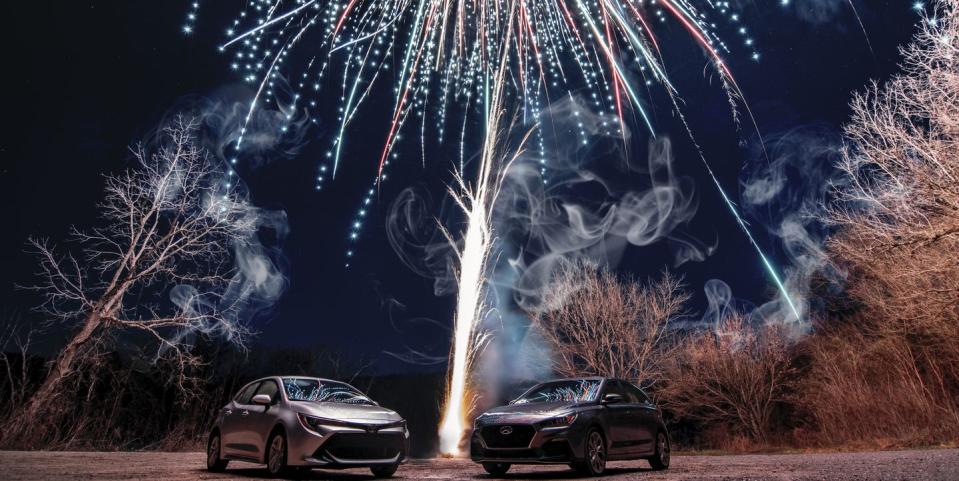
I was not cool in high school. Joyously so. And it turned out to be a forecast for life. Too much time being a dork for fun at the wrong moment, between the ages of 14 and 18.
Most of that time involved a car. Take a moment to remember the thrill of a fresh driver’s license. The new delight of transport freedom. Driving aimlessly and forever because it’s not home, because you have nothing but a car and time.
Then you get older, and time grows scarce. The release of a pointless day or evening becomes rare even though you end up needing it more and more.
This story originally appeared in the March/April 2020 issue of Road & Track.
So we dug up two test cars, affordable, first-car hatchbacks. We screwed off for a day, tearing into the hills, a kind of wheeled flashback, thinking about age. I’m 38 but my wife says I act 14. R&T’s occasionally juvenile senior editor, Zach Bowman, is 35 and from the hills of east Tennessee, where our test took place. Our photographer, Camden Thrasher, is 30 but seems ageless. He grew up in Washington State, which is like Tennessee with more West Coast. Stars, lined up.
Like high school, this story goes nowhere and somewhere all at once.
Enter the Corolla, Perpetually Punching Up

2019 Toyota Corolla SE. $20,910 base and as tested. A 2.0-liter I-4, 169 hp at 6600 rpm, 151 lb-ft at 4800 rpm. Front-drive. Six-speed manual or optional continuously variable automatic. A 3000-pound curb weight. Sixteen-inch wheels. A tasteful, lush, and remarkably well-assembled interior. Not much else.
For years, a Toyota Corolla has been as basic as cars get. Solid resale, unburstable engines and interiors. Few frills, but a chassis that won’t hurt you. Bad Corollas have no sin save dullness. Good ones are simple fun. This is a good one.
The SE is no hot rod. The brakes will go away if you lean on them too long. You’re not going to get any steering feel, ever. But the engine is cammy and lives for a razor-thin area at the top of the tach. The gearbox is clean and direct, the clutch light and easy. Back roads become maniacal games of momentum, trying to use as little brake as possible while reining in soft springs and dampers, flinging through 50-mph corners as tidily as possible. You revel in wringing the car’s neck. After all, anyone can master a Corolla. It’s a Corolla.
Two decades ago, a generation of kids fell into hand-me-down Asian econoboxes because those cars happened to be in the family and cheap. The industry has changed. The manual gearbox has become an endangered species. Everyone now wants an SUV or CUV, most of which look like sexless cows. But what fun Toyotas once did, this still does, better than ever.
Enter the Hyundai, Which Eats Corollas for Lunch
2019 Hyundai Elantra GT N-Line. $23,300 base; $24,300 as tested. A 1.6-liter turbo four, 201 hp at 6000 rpm, 195 lb-ft at 1500 rpm. Front-drive. Six-speed manual or optional seven-speed dual-clutch automatic. Another 3000-pound curb weight. Eighteen-inch wheels. A lush and remarkably well-assembled interior. Five seats. Little else.
We chose the Toyota because it’s harmless; the Hyundai less so. The Elantra GT N-Line is essentially an ordinary Elantra hatch with stiffer suspension, stiffer driveline mounts, and retuned steering. Spec the manual gearbox and Hyundai will throw in a set of Michelin Pilot Sport 4 summer tires. The car feels huckable and linear, like a Volkswagen GTI from a few years ago, before VW decided that car needed to be wide enough to straddle a lane and laggy with boost pressure. Talkative steering, ropey but precise shifter, enough brake. It bops into corners like a bunny. There’s far more grip and composure than in the Toyota, though the Elantra can feel nervous over bumps, as if the suspension only wants perfect roads. Driving either of these cars is a reminder that adults generally don’t buy small hatchbacks unless they have to. A hold-over, until you can afford That Really Good Adult Fun Car, which everybody young thinks is better. Turns out it’s not always better, just different. And generally more expensive.
Long Live the Airborne Fear of Death
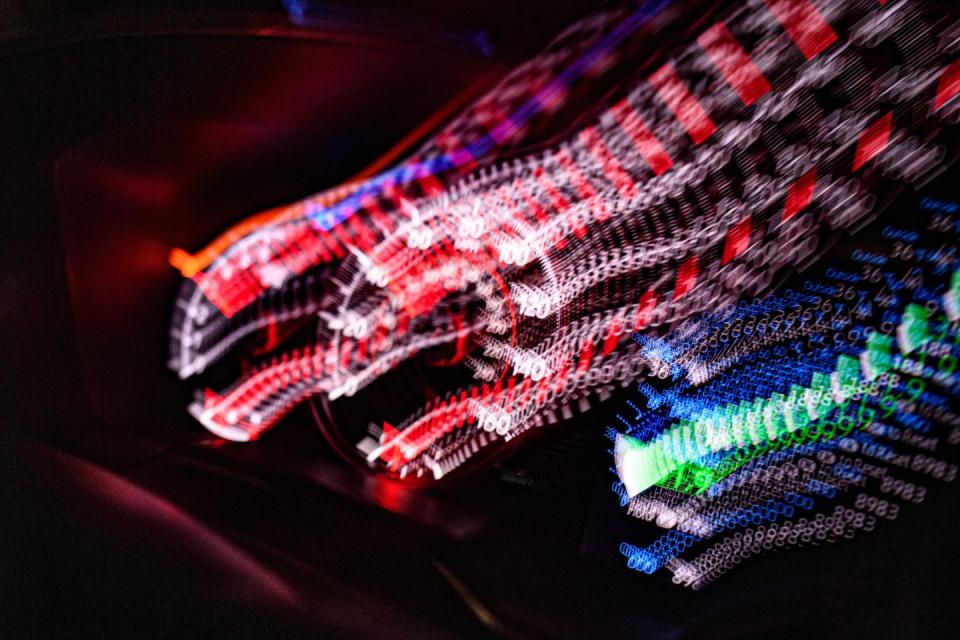
It began with talk of a jump. I never jumped a car in high school. Or maybe that’s what I told my parents. Maybe one jump, accidentally. Or more than one. You don’t talk about the jumps. Maybe they take away your license after that.
“I know just the place,” Bowman said. The pavement skated through open fields in the hills east of Knoxville. We parked beside the road and eyeballed it. A series of crests, the steepest a long, smooth tabletop.
“I used to run this in the dark,” Bowman said.
I squinted down the road. “Eighty, 90 miles an hour for wheels-up?”
He thought for a second. “More?”
“That,” I said, “would be irresponsible.”
We almost definitely did not stay and fly both cars at triple digits and full suspension droop, Camden crouched in a field with his good and crackly long lens as the sun began to set over the hills in a golden glow, because that would have been wrong.
“It takes work to get a car up there,” Bowman said, as we turned to leave. “More than I remember. Hell of a landing, though.”
Some small cars just whiff into the air easy. The Hyundai felt like it would fly well, zero drama. Stiff dampers. The Toyota, softer, would have probably taken more speed to launch, and longer to settle coming down.
I love that feeling. The skin-tingle you get as a small car decompresses from a landing. How a sort of cohesive settling ripples through the chassis like a dog shaking off after a bath.
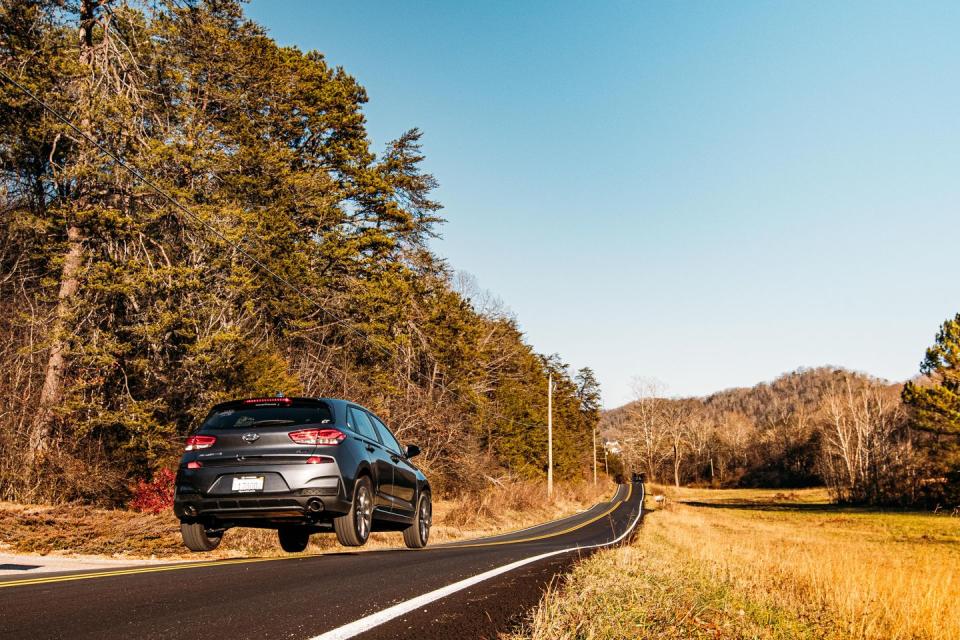
But there were definitely no jumps.
“Mom,” I Said, “We Were Just Out Driving Around”
It grew dark early, because it was winter.
We kept driving. I was reminded of how a country road at night feels like traveling through space alone, as if normal rules don’t apply. It was after five, the end of a work day. Technically, we could have gone home. But that didn’t feel right.
Lunch-tray slides felt right.
We bought fiberglass cafeteria trays from a restaurant-supply shop. Two dollars each. Also metal cake pans wide enough to hold the Hyundai’s relatively fat Michelins. (PS4s are expensive but fun on a bun. Road glue.)
Lunch-tray slides are simple: Place a piece of metal or plastic under the rear tires of a front-drive car. Set the parking brake. Drive. Experience the blessing of zero rear grip.
We found an empty industrial park miles from anywhere. And a problem: For reasons of packaging and cost, most modern cars now feature button-actuated electronic parking brakes. The Corolla and Elantra were not exceptions. Attempting to drive off with the brake engaged caused either car’s computer to disengage the brake. Convenient in the real world, but it gets in the way of a parking-lot dirty burn.
We spent several minutes poking at the Hyundai, pulling fuses for traction and stability systems. The brake kept releasing; no slides. I looked at Bowman.
“When I was 16, this wouldn’t have stopped me.”
“How?”
“I would have slapped a pair of vice grips on the rear brake lines to hold pressure, and then done donuts around a parking lot with the wheels locked.”
“Man, you have mellowed.”
“Maybe?”
I reached into the car and opened a bag of chips Camden left in the seat. Silent chewing. Bowman frowned, determined.
“You know what we’d do if we were in high school? We’d go to Gatlinburg and Pigeon Forge, and we’d buy throwing stars and fireworks. That is what we’d do if we were in high school.”
Gatlinburg is a tourist town. T-shirt shops. Pigeon Forge, nearby, is mostly famous for Dollywood, Dolly Parton’s theme park.
I watched the sun bend into a nearby ridge. My wife and kids were at home, about to sit down to dinner.
Bowman looked at me and repeated himself. “I said, throwing stars and fireworks.”
You Gonna Turn Down Flaming Balls, Old Man?
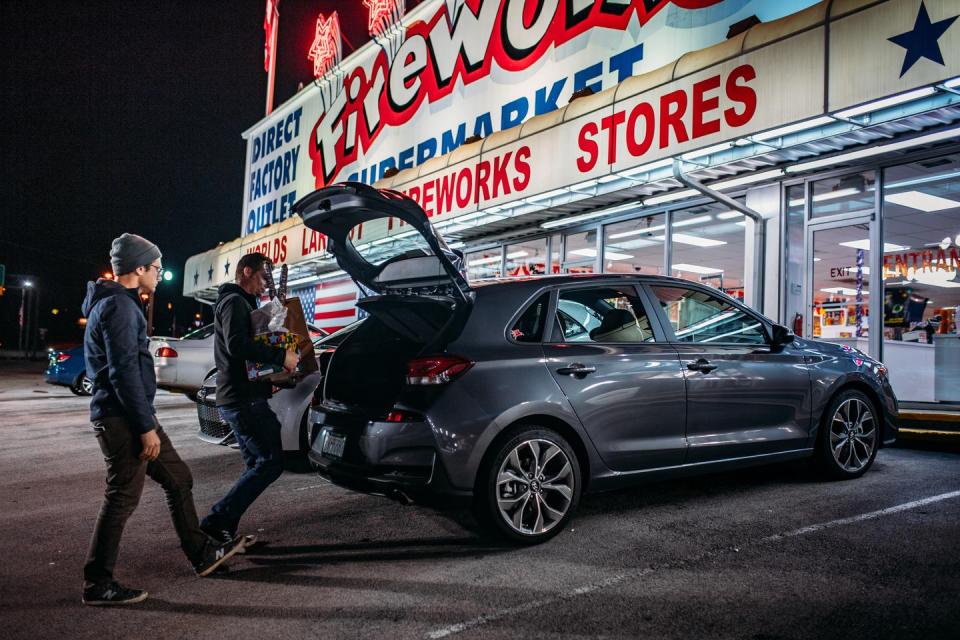
Daylight only lets you get away with so much. And my memory says the good parts of high school mostly happened at night.
Tennessee famously treats fireworks like New York treats pizza—sold 24 hours a day, industrial-strength only. The store we hit was a supermarket of boomery. F-I-R-E-W-O-R-K-S in big letters on the roof. Inside, Bowman, the native, became tour guide: This one is brighter; that’s a waste of money. This one, they don’t weight the base enough, it tips and fires rockets at you. I responded to everything with, “We need that. Buy it.”
Mortars. Smoke bombs. Sparklers the size of a five-year-old’s leg. And something called the Princess Purse: pink box, unicorns and a castle on the label. Only $12.95. It leaped off the shelf and into my hands.
Be the princess of pyro with this beautiful fountain! the label yelled. White-purple-gold raindrops of titanium! Then a disclaimer in bold, stern letters: WARNING: SHOOTS FLAMING BALLS.
Bowman raised an eyebrow. Thrasher shrugged, but then, Thrasher reminds you of a droll Jeffrey Lebowski, if Lebowski spent his career at race tracks, taking trippy photos of cars while eating too many snacks.
“Flaming balls,” he said, deadpan.
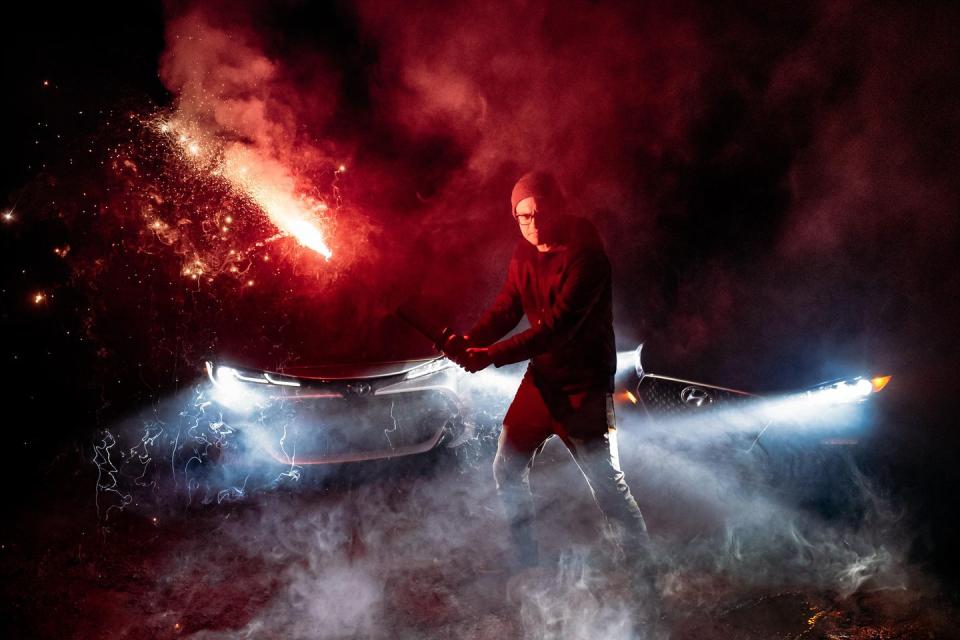
Bowman went to high school in Virginia, four hours away, where fireworks are illegal. “Fireworks were a big deal. Fridays, your friends would just hand you $20, and you’d bop over the state line. Buy as much as you could, then do a buck-ten back.”
“The state-line crossing must have been illegal,” I said.
“A trunkful of explosives? Are you kidding? If we’d been caught…”
I surveyed the surroundings. A Dunkin’ Donuts sat opposite the fireworks store, same parking lot. My stomach rumbled. “Do we need donuts for dinner?”
Again, the eyebrow raise.
“I ate a lot of stupid food in high school,” I said. “Generally treated my body like a trash compactor: What can we put in this and watch go away?”
I went in for six donuts and walked out with a discount dozen. They were rock-hard stale but also oddly delicious. When I got back, Bowman was leaned against the Toyota, shrugging at Thrasher.
“I didn’t do the traditional dumb stuff in school. Just going real fast, blowing shit up. We had a 150-mile loop, and we’d just rip around all night. If you stopped and saw a movie, great. If you got food, great. If not, you just ripped around for hours.”
So we ripped around for hours.
At the River, With Glory
We were standing under the moonlight at the river—some Tennessee river, I don’t remember which. A deserted public boat launch. Bowman was eating a donut, gesturing with it for emphasis, thinking out loud.
“The thing about the car? When you’re a teenager, it suddenly gives access to all these places that basically disappeared for you when the sun went down. You’re let loose for the first time, and you can just, say, come to the river at 9 o’clock.” I knew where he was going but said nothing. Partly because my mouth was full of donut.
“And weirdly, that only happens when you’re a teenager. The more freedom you have, getting older, the less you’re likely to be here. And the little shitboxes you drive in high school are the first things that give you that.”
These cars are not shitboxes, but you get the gist. I pulled another donut from the box. It was the consistency of cardboard but tasted of wet sugar, so I grabbed another and ate two at once. Bowman kept talking, a wistful look on his face, eyeing the river.
“Everybody likes to say cars are the keys to the universe… it’s easy to forget what that means, when you’ve been driving so long. Until then, everything is decided for you. The reason I didn’t drink or do drugs in high school was because I knew it could prevent me from getting in the car and going at any time. And my home situation was so shitty…I in no way wanted to take that from myself.”
When I discovered cars, they became the one place I felt half-normal. Because I never felt normal anywhere. Years later, you learn that seeming abnormality is the definition of normal for almost everyone. But when you’re young and ignorant, you chase what makes you feel better. In this case, a wheeled totem/home that delivers new places when almost everywhere feels like new places.
Bowman: “Even then, you know that there’s just such a narrow window. The years where the possibilities are endless, and…”
“Doors haven’t started to close,” I said.
“Right? Any Friday or Saturday night, it was just this.” He waved a hand at the road. “My friend Matt would sit in the passenger seat. At each intersection, he’d say left or right. And we’d go on until we ran out of time, arriving where-the-hell-ever.”
I threw a stale donut in the river and watched it float. More rockets lit into the air, the report washing through the hills. Mortars, the big guys that go foomp.
I lit the Princess Purse maybe too close to the Toyota, walked away, then took a step back toward it, worried about the car.
Bowman put a hand out. “Never move toward a lit firework.” (Metaphor alert: Your narrator will chase shiny things to his own detriment.) At that moment, as if on cue, the Purse spasmed out a rainbow—sparks of all colors, 15 feet in the air.
A minute later, Camden attempted to move the Toyota for a picture. He didn’t buckle his seatbelt. The car dragged its rear wheels when he hit the throttle. Locked.
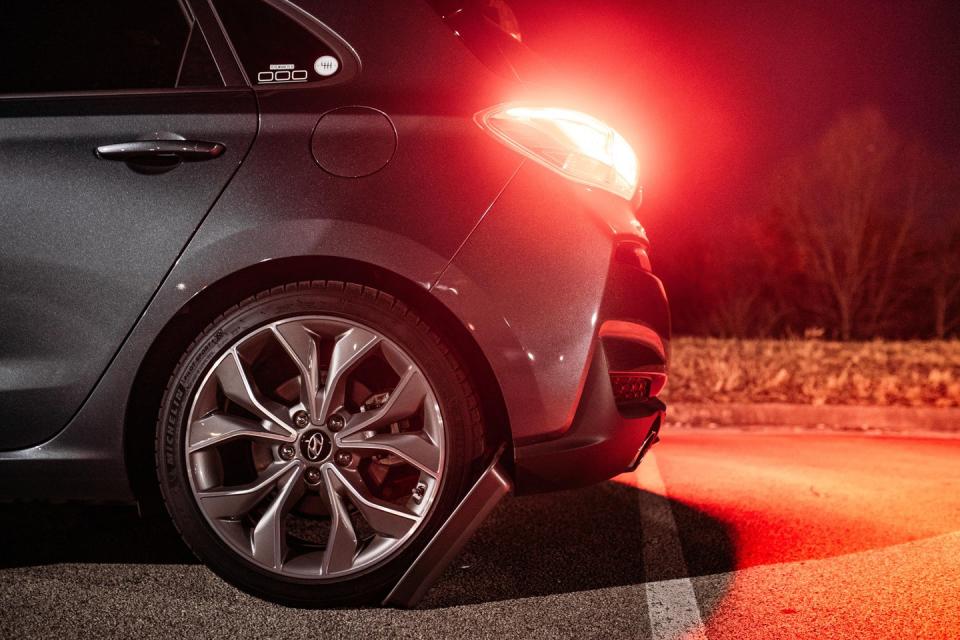
Bowman: “Wait. Seatbelt. Did we just figure out how to have the e-brake stick on?”
There in that moonlight, I may have cackled.
I texted a picture of an exploding mortar to my wife. She texted back about 20 minutes later. Not mad, just curious.
“It’s 10 o’clock on a Wednesday. Why on earth were you down at the river?”
This Wheel is on Fire. Also That One
Twenty minutes later, we were back at the industrial park. Turns out the seatbelt trick was the answer: Stay unbuckled, the Toyota and Hyundai would each power the drive wheels but leave the parking brake on. High off firework sulfur, I put the metal baking pans under the Hyundai on the theory that metal plus asphalt always equals mayhem.
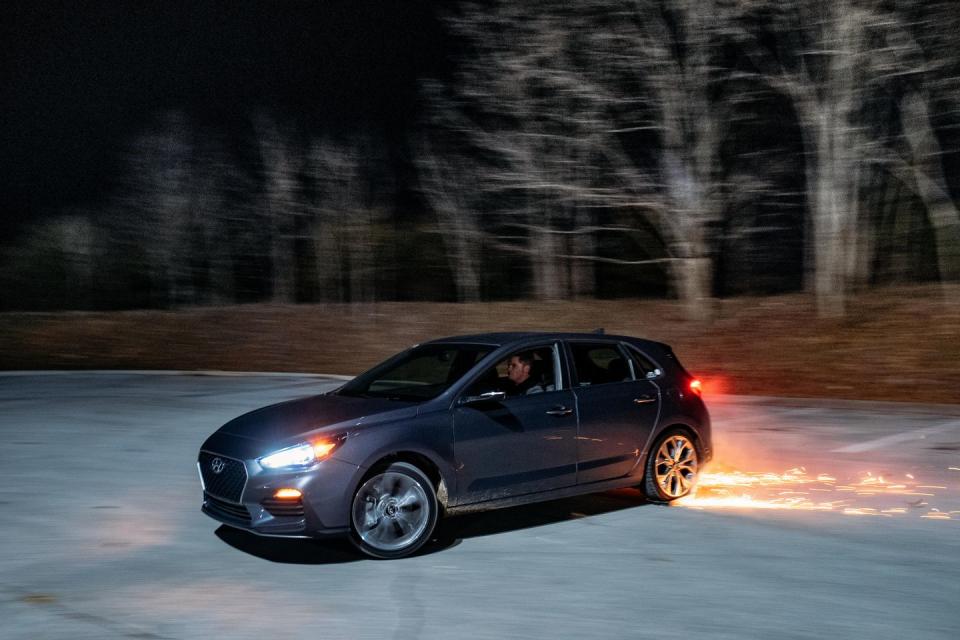
Bowman eyed the pans. “We all miss the handbrake,” he announced, solemnly, “not because it’s a better solution to the problem. Because it doesn’t prevent us from being assholes.” Then he got in the car and dumped the clutch, ripping toward the other side of the lot. A fountain of sparks rooster-tailed off each locked wheel. I clapped slowly, hands high in the air, walking toward the car. The Elantra arced around a light pole half-backward at 8 mph. The pans bent, collapsed, blued from heat, then finally gave up and wore through. The air stunk of roasted metal and cooked enamel. A face popped out of the open driver’s window. Eyebrows up.
“Good?”
“Oh, was it good.” My face hurt from grinning.
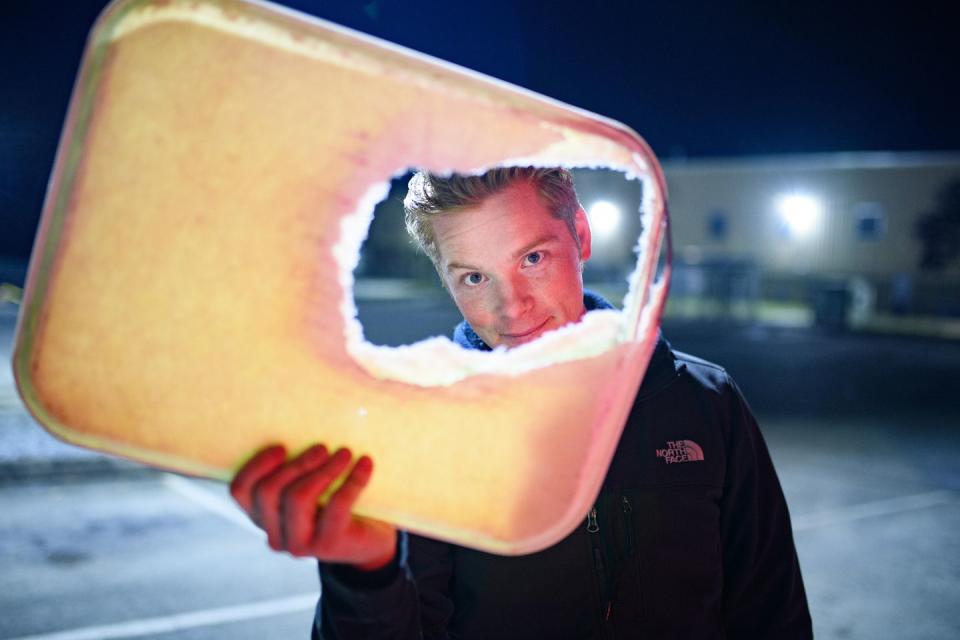
The lunch trays were next. I put them under the Toyota and flung the car into a pirouette. When the fiberglass inevitably wore down, something told me to stay in the throttle. White smoke poured into the cockpit, blotted out the moon, felled small trees.
“Once the trays burned through,” Bowman said after, “I thought, Should we tell him they’re gone?”
Thrasher looked down at his camera, reviewing what he’d shot. “He knew, I think.”
Trails of white fiberglass dust crossed the parking lot. They turned to black, an impression of the Toyota’s tread, near the burnout. Like a sunrise, it made me quietly happy without reason.
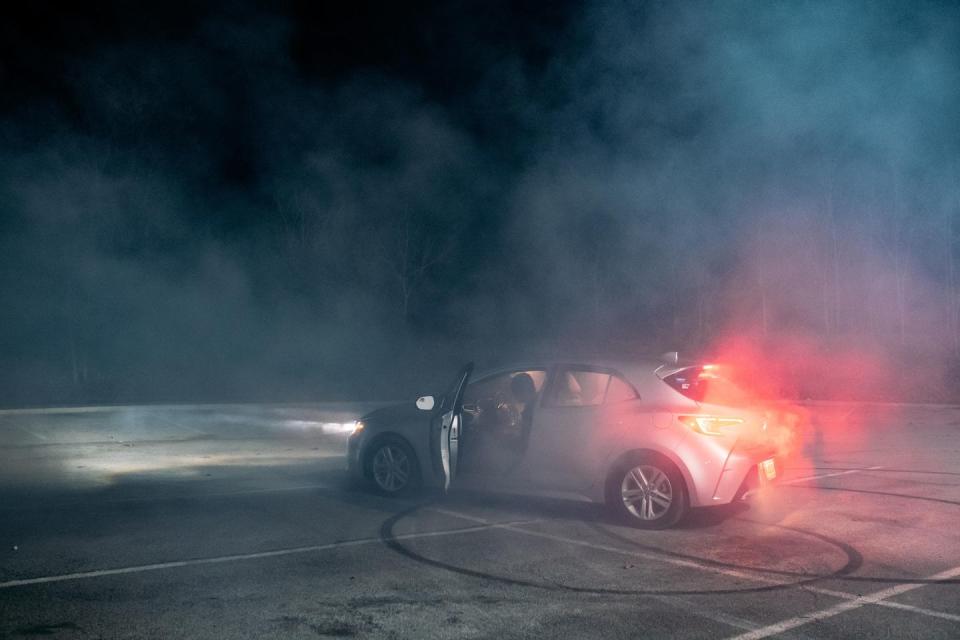
Love for the well-executed ordinary can be hard to explain. On the surface, a 169-horse Corolla is just a quiet little penalty box with no power and a manual gearbox. Some people view that too much like work. But on the right kind of road, a manual Corolla or Elantra GT could probably run down Porsches. Reachable performance, too friendly to bite.
At 16, some part of you knows that. As much as I love a good Porsche, I’d rather be ripping the nuts off some middle- of-nowhere two-lane in a manual Toyota or an old Craigslist find with a cam and a soda in the cupholder and nowhere to be. As I did, then.
This might be what makes me, me. And is probably why, as an old editor once pointed out, no one should listen to me about cars, ever. At least until I grow up.
So good luck, waiting on that.
Finally, at Long Last, the Waffle House at Midnight
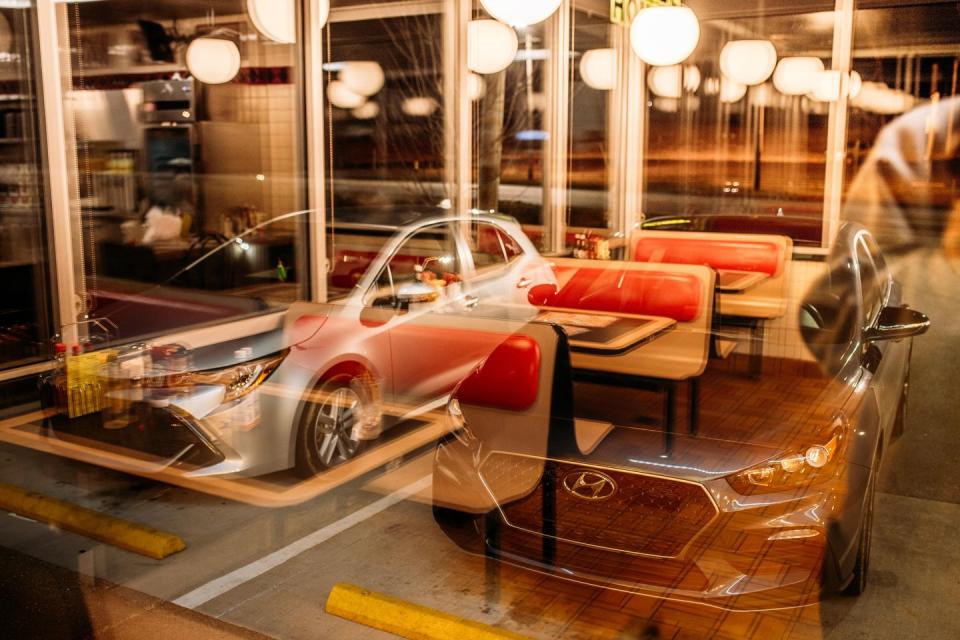
We ended at a diner in the wee hours. High-school weird nights always ended at a diner in the wee hours. There was something about cheap eggs and staying at a table until someone told you to leave, because you had paid the check an hour ago and the refills were done and the waitress said get out.
I miss it and don’t. A time of small problems that seemed big and big ones that seemed small. I vividly remember spending my teenage years confused about almost everything. Wondering if my life was going to be great or struggle or something in between. As it turns out, for most people, the answer is just yes. Life is good and terrible in equal measure, and better for it. Sometimes you just aren’t in a place to appreciate the subtlety.
At 38, you wake up the next day exhausted and bleary from the sugar and hours and miles. Your body hurts in a way that it once didn’t. But it’s offset by the warm glow of remembering what it was like to grab the keys and feel, for the first time and maybe also the last, completely and totally free.
Lord help us if we ever forget.
The FWD Cheat Code: Outsmarting the Electronic Handbrake
Technology can occasionally put a damper on hooliganism. Want to chase lunch-tray slides or front-drive burnouts but keep getting shut down by an automated park brake? Most cars automatically release the brake the moment you hit the throttle, but some can be outsmarted. Here’s one option that works in more than a few models, regardless of manufacturer. Just don’t call us when you tag a pole or flat-spot a tire—that’s between you and mom.
1. Start the car. 2. Take off your seatbelt.*
3. Set the electronic parking brake.
4. Accelerate.
The car should now move with the rear wheels locked, just as if you’d pulled the lever on an old-fashioned mechanical system. Weirdly, the seatbelt is the crucial part. Leave it on, and the system will disengage the brake.
*All testing done on a closed course. R&T does not endorse illegal or unsafe activity. This information should not be used by anybody for any reason. Always wear your seatbelt.
You Might Also Like

 Yahoo Autos
Yahoo Autos 